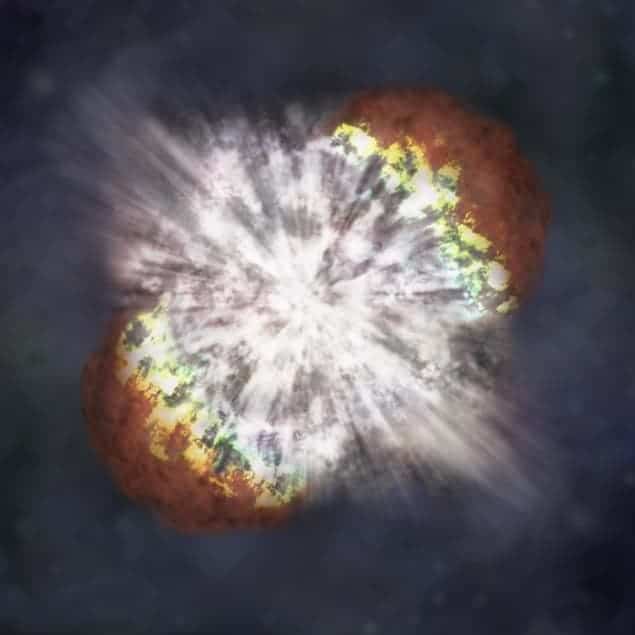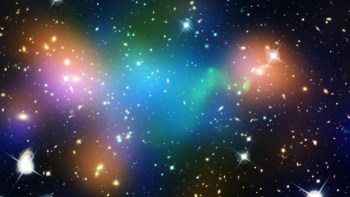
Scientists have long wondered where the observed magnetization of the interstellar medium came from, given that the fully ionized gas of the early universe contained no magnetic particles. According to new research by an astrophysicist in Germany, the answer lies in magnetic fluctuations within this plasma. Although these fluctuations initially summed to zero, he calculates, they would have left a positive excess of field once compressed by energetic phenomena such as supernovae explosions.
Permanent magnetism is a property of only a few materials, such as iron, in which the spins of individual electrons naturally line up in the same direction and create a residual magnetic field. In the early universe, before iron and other magnetic materials had been created inside stars, permanent magnetism did not exist. Nevertheless, the proto-interstellar medium, a plasma consisting of a few light nuclei along with free protons and electrons and which formed when the universe was less than a billion years old, did have a non-zero magnetic field.
Magnetic seeds
Astrophysicists believe that the explosive collapse of massive stars known as supernovae or the streams of charged particles referred to as galactic winds could have provided the energy needed to compress small and disordered, or “seed”, magnetic fields so that they became unidirectional and as strong as the fields observed in the interstellar medium – that is, having an energy density roughly equal to that caused by the medium’s thermal pressure. The question is: where did these seed fields come from?
To answer this question, Reinhard Schlickeiser of Ruhr University in Bochum considered the proto-interstellar plasma shortly after it came into being – an era known as “reionization” when something, probably the light from the first stars, provided the energy needed to break up the previously neutral gas that existed in the universe. The protons and electrons inside the plasma would have moved around continuously, simply by virtue of existing at a finite temperature. And, like any charged particles in random motion, they would have created random magnetic fields – which would have cancelled each other out. Nevertheless, it was the finite variance of the resulting magnetic “fluctuations”, says Schlickeiser, that subsequently led to the creation of a permanent magnetism across the universe.
To work out the field-strength variance of the fluctuations, Schlickeiser used a theory he developed in 2012 with Peter Yoon of the University of Maryland. The fluctuations are “aperiodic”, which means that, unlike the variations in magnetic and electric fields that give rise to electromagnetic radiation, they do not propagate as a wave. Indeed, their wavelength – the spatial distance over which the fluctuations occur – and their frequency – dictating how long these fluctuations last – are uncorrelated, in contrast to light, for which the values of wavelength and frequency are tied to one another via the wave’s velocity.
Much weaker than a fridge magnet
Schlickeiser summed over all possible wavelengths and frequencies for the magnetic fluctuations in a gas at 10,000 K, which would have been roughly the temperature of the proto-interstellar medium at the time of reionization. The calculation revealed field strengths of about 10–12 G inside very early-stage galaxies and around 10–21 G in the void surrounding the galaxies. These values compare with the roughly 0.5 G of the Earth’s magnetic field and the 100 G typical of a strong refrigerator magnet.
Schlickeiser points out that he is not the first person to put forward a seed mechanism for the interstellar magnetic field. Indeed, as far back as 1950 the German astronomer Ludwig Biermann proposed that the centrifugal force generated in a rotating plasma cloud will separate out heavier protons from lighter electrons, thereby creating a separation of charge that leads to tiny electric and magnetic fields. According to Schlickeiser, however, this scheme suffers from a lack of suitable rotating objects, meaning that it could only ever generate the magnetic fields in a small portion of the interstellar medium.
Observational evidence needed
Schlickeiser’s next step is to find observational evidence to back up his idea. One option, he says, would be to look at the cosmic microwave background, the very faint long-wavelength radiation that fills the universe and which was emitted about 400,000 years after the Big Bang, when electrons and protons had cooled to the extent that they could combine via mutual attraction and leave photons to propagate freely through space. The idea would be to measure variations in the polarization of this radiation, which could be done using data from the European Space Agency’s Planck satellite, given that magnetic fields rotate the plane of polarization of electromagnetic waves. “It is not clear at the moment whether these fluctuations would have measureable effects on the background radiation,” he says. “But I think it would be worth finding out.”
Massimo Stiavelli of the Space Telescope Science Institute in Maryland is positive about the latest work, arguing that “the mechanism described could indeed provide the seeds to primordial magnetic fields”. And he suggests an alternative line of evidence, from before reionization – that any magnetic fluctuations would have tended to fragment the universe’s second generation of stars as they formed. “Finding somewhere in the local universe a small-mass star with a magnetic field and primordial chemical composition would provide evidence that a mechanism like the one described was at play,” he says.
The research is published in Physical Review Letters.



